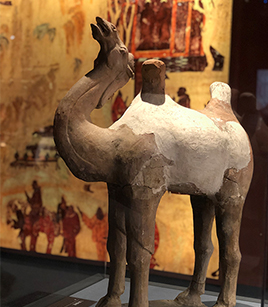Silk Road

An ancient piece of tri-colored glazed pottery displayed at an exhibition of the cultural relics along the Silk Road Photo: Zeng Qi/CFP
The Silk Road, in a narrow sense, refers to a network of land routes connecting ancient China with Central Asia, West Asia, Africa, and the European continent. In its broad sense, the Silk Road also includes the sea routes connecting China, Southeast Asia, the Indian subcontinent, the Arabian Peninsula, Somalia, Egypt, and Europe, which flourished from the 2nd century BCE till the First Opium War (1840–1842) in the Qing Dynasty. The term “Silk Road” was first noted by the German geographer Ferdinand von Richthofen (1833–1905) in the late 19th century.
The land routes appeared as early as the Western Han Dynasty (206 BCE–8 CE) and were originally travelled by merchants carrying silk from China to Europe, where it dressed royalty and wealthy patrons. Other commodities from Asia included jade, porcelain, and tea. In exchange, horses, glassware, textiles, and manufactured goods traveled eastward. As a main channel for ancient China to open up to the outside world, the Silk Road functioned not only as a trade route, but also a bridge that linked the ancient civilizations of the East and the West.
According to Sally K. Church, a researcher at the Needham Research Institute, China’s Silk Road (whether it is the Silk Road on the land or the Silk Road on the sea) has always been a lively cultural exchange, and most of it has been a two-way cultural communication, or multi-directional cultural infiltration or complementation. She has long studied the historical Silk Road and the reality of cultural exchange. She believes the Silk Road was an inspiration for many cultural exchanges between the East and the West. In her way of thinking, the valuable commodity of trade was not only silk, but also ideas. The confluence and intermingling influence of ideas is what truly made the Silk Road valuable to world history.
Edited by REN GUANHONG
